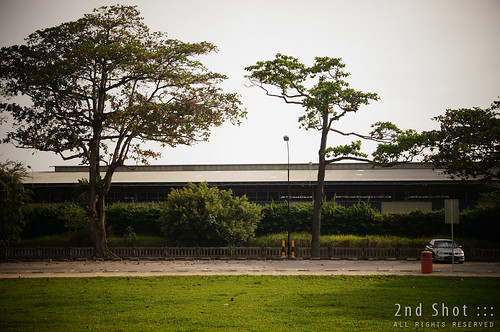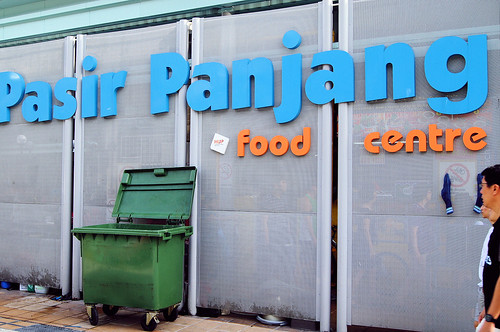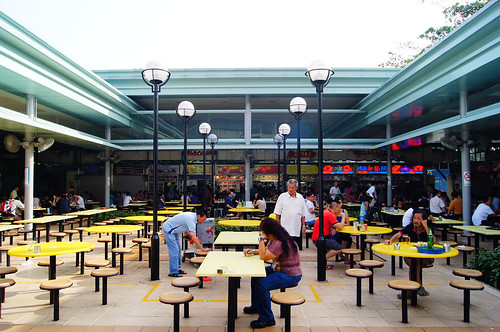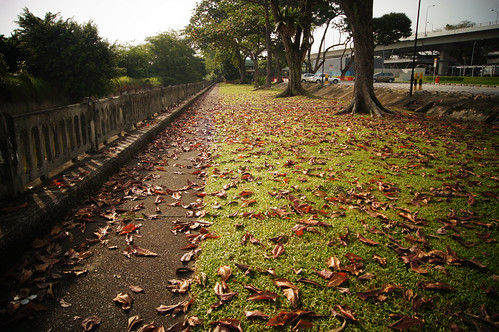Pages
▼
Apr 1, 2012
The Cannon that Disappeared from Pasir Panjang Park
Previously I blogged about the disappearing Old Jalan Kayu Post Office. It is kind of insidious and many may not even realize it; slowly but surely we are losing bits and pieces of our heritage. Small objects disappear too just like buildings. With no fanfare, one relatively unknown cannon had disappeared from a small park in Singapore.
During the Circle Line Discovery last year when everybody had their ride free the whole day, I made it a point to alight at Pasir Panjang Station. The new station made it more convenient to visit Reflections at Bukit Chandu and boosted stall businesses at Pasir Panjang Food Centre, in fact both are listed as "circle line attractions" on SMRT website, but they were not the reason for my visit. The real gem is the uber small Pasir Panjang Park and a small cannon located in it, as far as heritage is concerned. According to one source, the park was established before the war. However SMRT or LTA were no believers of this small gem, so it was not singled out as a circle line attraction.
Pasir Panjang Food Centre, one of the "circle line attractions" listed on SMRT website.
I was not surprised to find the food centre renovated though I do not remember it had alfresco dining so this was probably added later. After buying a drink - takeaway in a plastic bag - I hastily made my way to the park beside it.
Al fresco dining at Pasir Panjang Food Centre. According to SMRT's description of the attraction, this place is "popular for its wide variety of bbq seafood and Malay food". I guess this is where al fresco dining comes into play.
The park felt different compared to my previous visit. First I was the only one in the park. Secondly, there was no bench or a place to rest our butt in the park, which probably explains the first observation. Last but not least, the cannon in the park that I first know of from Victor's blog was missing!
Where is this cannon presented by HJC Kulasingha in 1957? Kulasingha was a Progressive Party candidate and Assemblyman for Bukit Timah in the 1951 General Elections. He lost by a narrow margin (49.4%) in Southern Islands in the 1955 General Elections (in today's context he would likely become a NCMP). He was chairman of the Pasir Panjang Rural District Committee but lost in the four-cornered fight to take Pasir Panjang in the 1959 General Elections. It seems that the cannon did not help him take down Pasir Panjang in 1959. See this website for the election numbers.
Do you know the fate of this 'Kulasingha cannon'?
From Victor's photo in his blog, the cannon seems to have disappeared from its original location after the first tree from the food centre. Click my photo for a larger resolution.




Is this a quiz, Icemoon? That is, do you know the answer? (I don't.)
ReplyDeleteI also don't :(
ReplyDeleteThanks for this piece. Another pathetic erasing of our history. That the two stat boards (SMRT,LRT) did not even ackownledge the historic value of the park is a disgrace.
ReplyDeleteBut hey what's new. What's a park and a cannon when compared to a filthy hawker centre that's frequented by rowdy, sweaty dockers.
Icemoon - Since the softscape & hardscape of Pasir Panjang Park (PPP) are under NParks' purview, why not try asking NParks why the Kulasingha cannon was removed, & where it was sent to ?
ReplyDeleteIf I were to hazard some wild guesses, perhaps the cannon is being stored at Pasir Panjang Nursery, or else displayed somewhere in Kent Ridge Park or even Gardens By The Bay. I won't be surprised either, if the whimsical-looking cannon were to turn up in one of the show gardens at S'pore Garden Festival 2012.
I recall seeing the mini cannon, when I was at PPP in 2009. Well, at least the quaint stone/concrete railings beside have not been removed or "upgraded". Comparing these weather-beaten railings with old photos of PPP, it appears that railings are the same ones that originally ran along the sea-front of the park.
From post: "According to one source, the park was established before the war."
ReplyDeleteThat's right. Since I have yet to come across any substantial historical write-up about Pasir Panjang Park, let me summarize what I discovered from NLB's newspaper archive about the park's chequered history. This is definitely one of those parks which both the Municipal & the people fought very hard for -- to bring it into existence, & to keep it intact.
The original 5-acre site beside the sea used to house a former mental hospital & a beri-beri hospital. Between 1928 & 1930, there was a long-drawn debate between the Municipal Council (which wanted to convert the disused site to a public seaside park) & the colonial government (which was strongly against the idea). Mr J.W. Harries of the Municipal had envisioned a green belt of public coastal parks stretching from the proposed Pasir Panjang Park all the way to Katong, so as to counter private individuals who were enclosing much of the remaining seafront.
Development works apparently began in 1931 & by May 1933 (or earlier), Pasir Panjang Park had come into existence. The park became very popular as an outdoor sports venue -- it had a football-cum-golf field which was also used as a play area by European kids.
By Sep 1937, the palms & flowering shrubs in the park proved so attractive that they were "taken away" at night by nearby residents -- & transplanted into their own gardens. (To deal with these plant thefts, the S'pore Rural Board proposed to protect the park's flora with "a high enclosure of barbed wire" !)
In the run-up to WWII, the park was one of 2 sites (the other being S'pore Botanic Gardens) used as demonstration plots for growing vegetable crops & fruit trees in the government's campaign to encourage self-sufficiency in food supplies.
During the WWII occupation, the Japanese army apparently "reduced [the park] to shambles", & built 3 big timber buildings on the site for use as army camps. In the immediate post-war period, the site became out-of-bounds to the public, as the British military was using it as a army depot until Jun 1951.
[continued in the next comment]
[continued from the previous comment]
ReplyDeleteAfter the Rural Board reacquired the site in Jun 1951, a series of disputes arose over how the place should be utilized. The Rural Board declined to convert the site back to open space, but instead leased out 2 of the buildings to the Colonial Police for use as living quarters by its married officers. Earlier in May 1951, the Rural Board suggested that a replacement park be built "on the opposite side of the road", but this was met with opposition from the public who felt that the "barren ridge" (ie. now Kent Ridge) was too steep & inaccessible.
In the same month, Mr H.J.C. Kulasingha (chairman of the Pasir Panjang Rural District Committee) proposed to use one of the big timber buildings at the park as a temporary community hall. However, the plan was abandoned in Apr 1952, because Mr Kulasingha felt that the "estimated $30,000 for repairs was 'a colossal amount' to spend on such 'an old building'".
The Colonial Police returned the site to the Rural Board in Jun 1954. Subsequently, the "dilapidated" buildings were demolished & some improvements made to the site, before it was officially re-opened as a public park by the Chief Minister on 23 Jul 1955.
In Jan 1956, the Rural Board announced a $70,000 "face lift" project that aimed to transform Pasir Panjang Park into a "rural seaside promenade". The redevelopment plan included a new playground, swimming facilities, bathing & changing rooms, park benches, flowering shrubs, as well as hawker's stalls & a carpark. (Note: The mini cannon as presented by Mr Kulasingha in Jan/Feb 1957 was most likely meant to commemorate the launch of the re-developed park.)
Over the next 25 years, Pasir Panjang Park appeared to be a "happening" destination visited by nearby residents & even tourists. The Police Band also held regular public concerts there, while the Pasir Panjang Boys' Club provided movie screenings at its club house located beside the park.
In Jun 1980, a member of the public (who had observed "rapid reclamation work" along the western coast of S'pore) wrote to the ST Forum with a suggestion to extend the park all the way to West Coast Road, & proposed that the new coastal belt be called "West Coast Parkway".
Today, looking at the tiny Pasir Panjang Park & the ghastly Pasir Panjang Container Terminal that had since invaded most of the southwestern coast of S'pore, my reaction is: Alas, alas ... what happened ??
[continued from the previous comment] - 2nd attempt at posting
ReplyDeleteAfter the Rural Board reacquired the site in Jun 1951, a series of disputes arose over how the place should be utilized. The Rural Board declined to convert the site back to open space, but instead leased out 2 of the buildings to the Colonial Police for use as living quarters by its married officers. Earlier in May 1951, the Rural Board suggested that a replacement park be built "on the opposite side of the road", but this was met with opposition from the public who felt that the "barren ridge" (ie. now Kent Ridge) was too steep & inaccessible.
In the same month, Mr H.J.C. Kulasingha (chairman of the Pasir Panjang Rural District Committee) proposed to use one of the big timber buildings at the park as a temporary community hall. However, the plan was abandoned in Apr 1952, because Mr Kulasingha felt that the "estimated $30,000 for repairs was 'a colossal amount' to spend on such 'an old building'".
The Colonial Police returned the site to the Rural Board in Jun 1954. Subsequently, the "dilapidated" buildings were demolished & some improvements made to the site, before it was officially re-opened as a public park by the Chief Minister on 23 Jul 1955.
In Jan 1956, the Rural Board announced a $70,000 "face lift" project that aimed to transform Pasir Panjang Park into a "rural seaside promenade". The redevelopment plan included a new playground, swimming facilities, bathing & changing rooms, park benches, flowering shrubs, as well as hawker's stalls & a carpark. (Note: The mini cannon as presented by Mr Kulasingha in Jan/Feb 1957 was most likely meant to commemorate the launch of the re-developed park.)
Over the next 25 years, Pasir Panjang Park appeared to be a "happening" destination visited by nearby residents & even tourists. The Police Band also held regular public concerts there, while the Pasir Panjang Boys' Club provided movie screenings at its club house located beside the park.
In Jun 1980, a member of the public (who had observed "rapid reclamation work" along the western coast of S'pore) wrote to the ST Forum with a suggestion to extend the park all the way to West Coast Road, & proposed that the new coastal belt be called "West Coast Parkway".
Today, looking at the tiny Pasir Panjang Park & the ghastly Pasir Panjang Container Terminal that had since invaded most of the southwestern coast of S'pore, my reaction is: Alas, alas ... what happened ??
Icemoon - My 2 attempts at posting the 2nd part of my comment (the 1st part is dated April 4, 2012 7:54 PM) about the history of Pasir Panjang Park disappeared into blackholes, after they were published by Blogger.
ReplyDeletePerhaps my comments are stored in your spam folder. You might wish to release one of the posts, if you think the content is worth reading. :)
Pat, your comments have appeared. I have 'unspammed' them from the spam folder, lol
ReplyDeleteThanks for the summary, let me put them in a more prominent place, in a new post.
Done! I have put Pat's comments in my new post.
ReplyDeleteIt’s now at the new Pasir Panjang Park container shelter 2.
ReplyDelete